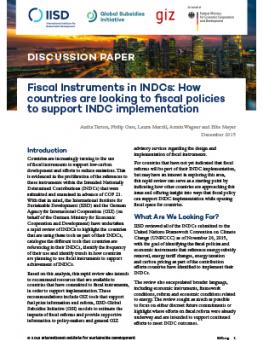
Fiscal Instruments in INDCs: How countries are looking to fiscal policies to support INDC implementation
Countries are increasingly turning to the use of fiscal instruments to support low-carbon development and efforts to reduce emissions.
Countries are increasingly turning to the use of fiscal instruments to support low-carbon development and efforts to reduce emissions.
This is evidenced in the proliferation of the references to these instruments within the Intended Nationally Determined Contributions (INDCs) that were submitted and examined in advance of COP 21.
With that in mind, IISD and GIZ (on behalf of the German Ministry for Economic Cooperation and Development) have undertaken a rapid review of INDCs to highlight countries that have identified these tools as part of their INDCs, catalogue the different tools countries referenced, detect the frequency of their use and identify trends for how countries are planning to use fiscal instruments to support the implementation of INDCs.
Based on the analysis, this review provides several recommendations, in order to highlight resources that support the implementation of fiscal instruments countries have committed to in their INDCs. For countries that have not yet indicated that fiscal reforms will be part of their INDC implementation, but may have an interest in exploring this area, this rapid review can serve as a starting point by indicating how other countries are approaching this issue and offering insight into ways that fiscal policy can support INDC implementation while opening fiscal space for countries.
You might also be interested in
Unlocking Supply Chains for Localizing Electric Vehicle Battery Production in India
This study aims to highlight the key supply chain barriers in localizing electric vehicle (EV) battery cell manufacturing in India. It summarizes consultations with 12 companies, as well as experts and policy-makers, to determine the crucial challenges and opportunities in localizing battery manufacturing in India.
COP 29 Must Deliver on Last Year’s Historic Energy Transition Pact
At COP 29 in Baku, countries must build on what was achieved at COP 28 and clarify what tripling renewables and transitioning away from fossil fuels means in practice.
IISD Welcomes Draft Regulations for Oil and Gas Pollution Cap
A firm cap on emissions can provide certainty for industry to invest in decarbonization, while ensuring the sector is on a path to net-zero by 2050.
What Will Happen at COP 29?
Talks at the 2024 UN Climate Change Conference (COP 29) will range from defining a way forward on finance through a new collective quantified goal (NCQG) to mitigation, and loss and damage. Ahead of negotiations in Baku, IISD’s Earth Negotiations Bulletin Team Lead Jennifer Bansard examines the agenda and breaks down what to watch as eyes turn to Azerbaijan.